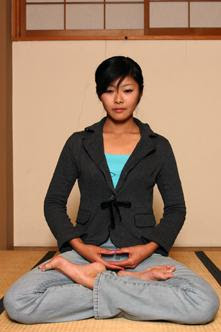Initially keep your head straight, spine erect, hands on the knees and mouth should be closed.

yoga posture
Concentrate on the pharyngeal space which is at the back wall of your mouth, then slightly contract its muscles, Draw in the air through that space just like using a suction pump.
Be slow and steady, letting the pumping sound be clearly heard. Avoid the use of nostrils; Nostrils remain inactive during the entire respiration process.
While drawing air, let your ribs expand sideways like an accordion-beginning with the lower ones, of course. The entire inhalation should be done gently and effortlessly and make chest and shoulders motionless.Pause for a second or two after the completion and slowly breathe out. The upper ribs are now contracted first, the nostrils remain inactive and the chest and shoulders motionless.
At Last, push in the stomach a little so as to push out all the air.
- Yep, This is your first deep breath.
- Do not try to take too full a breath at once. Start by breathing to the count of four. Then hold the breath, counting to two, and start slowly exhaling, again to the count of four. Breathing in and out to an equal number of beats is called rhythmic breathing. make a rhythmic pattern. Don't just stop at the end of the count when there is still air to be expelled. Adjust your breathing to the timing. Repeat, but do not take more than 5 or 6 deep breaths at one time during the first week. Don't do more although you enjoy it.
- You must be careful in some cases. Don't overdo the breathing, especially inhalation, as this may lead to unpleasant results such as dizziness, nausea, headaches. The complete breathing increases the lung capacity. But this increased capacity should come gradually rather than by force. You may continue to employ all of the muscles and all portions of the lungs in breathing without expanding the lungs to their maximum extent each time you inhale.
- As your cycle of breathing involves an increasingly larger lung area, your respiration may be decreased correspondingly while the amount of oxygen available for use remains the same-or even increases. Slower, deeper breathing not only stimulates the lungs into healthier action, and brings more of the body muscles into play, but it has the effect of calming the nerves. Although other factors must be taken into consideration, the slower your respiration rate the calmer you feel. You can deliberately reduce this rate for beneficial effect. However, you can maintain this only if you breathe more deeply.
A complete breath involves the following steps:
1.Fill your lungs by inhaling slowly. Some recommend that you begin with abdominal breathing, gradually move into middle breathing, and finish filling the lungs with high breathing.
2.A pause, short or long, should occur at the end of inhalation. Don't force at first.
3.Slowly exhale. Again, some recommend beginning exhalation with high breathing, proceeding gradually to middle breathing, and ending with abdominal breathing and use of abdominal muscles to expel all air from the lungs.
4.Pause at the end of exhalation. This too should not be forced at first, though this pause may prove to be even more significant than the first as a stage in which to seek and find a kind of spiritual quiescence that can be most powerful in its relaxing effects.
No comments:
Post a Comment